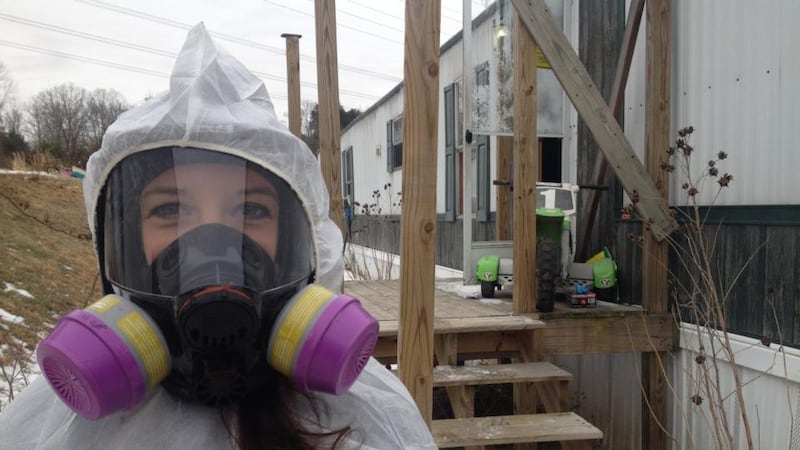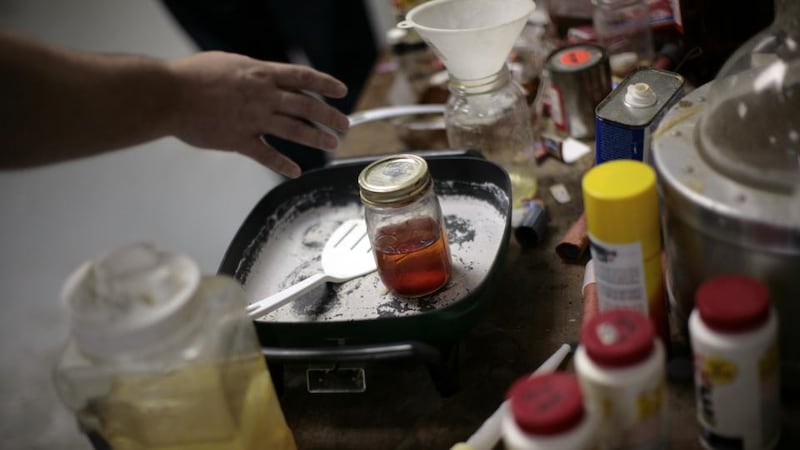The skip is filling with household items, furniture and toys. They have been removed from a mobile home in a trailer park in West Virginia, the latest illegal methamphetamine lab to be raided by police in the second-poorest state in the US, and are being discarded because they are contaminated.
Fans of the US television series Breaking Bad know this highly addictive drug as crystal meth. The most common method of cooking meth in West Virginia is nothing like what goes on in the high-tech lab run by Walter White, the fictional chemistry teacher turned drug manufacturer.
“It is not anywhere comparable to the size or the money they are making on the show. They are small, small labs here in West Virginia,” says Mike Goff, a former state police officer and now administrator of West Virginia Board of Pharmacy’s controlled-substance monitoring programme.


Jennifer Rhyne, owner of Affordable Cleanup, a meth-lab remediation company, and two staff are working on the mobile home in the town of Scott Depot, 30km west of Charleston, the state capital, beyond chimney stacks and chemical plants that billow smoke skywards.
The "shake-and-bake" meth-making method that is popular in West Virginia involves a plastic drink bottle, salt, lithium from a battery, basic household chemicals and a key ingredient, pseudoephedrine, from over-the-counter cold medicines. It takes an hour to make meth this way. "All we have ever seen is the shake-and-bake method. Landlords say this isn't a lab. Shake and bake is a lab. It's a lab in a bottle," says Rhyne.
Dressed in full-body hazardous-materials – or hazmat – suits and respiratory masks, Rhyne’s staff work through the mobile home, which is still scattered with personal belongings and toys, now toxic from the meth chemicals that can cause major respiratory problems.
One of the cleaners, Heath Barnett, shows two syringes he found in the bathroom lab. Addicts snort or smoke meth, or burn it on a spoon and inject it. The mobile home had been occupied by a mother of two whose father had bought her a place to live in.
A woman and her dog emerge from a mobile home next to the former Scott Depot meth lab that Rhyne’s staff are cleaning up. It is bitterly cold. “I had a feeling there was something going on,” says the woman, who doesn’t want to be named. “There was too much traffic, and they had the back door open all the time, with the fans going.
Trailers to $250,000 houses
Affordable Cleanup has been in business for a year, in which time it has remediated 17 properties, from trailers to $250,000 houses, in which meth labs were discovered. As president of a landlords' association, she saw the money to be made from cleaning the increasing number of labs being found in Kanawha County, West Virginia's most populous county, and surrounding areas.
Five hundred and thirty-three meth labs were raided in the state last year, up 85 per cent on the 2012 figure. Seven meth clean-up companies operated in the area a year ago, says Rhyne. Now 17 do. A clean-up costs €7,500 a property, and the loss to the landlord averages about €12,500, according to Rhyne.
Cleaners encounter heartbreaking scenes. One woman in her 80s discovered that her grandson had been cooking meth in her home without her knowledge, resulting in a lifetime’s worth of belongings being destroyed. Barnett says they have found children living in 90 per cent of home labs the company has cleaned. In 90 per cent of those cases the cleaners have discovered breathing treatments such as salbutamol inhalers: the cooks are so addicted that they simply seek treatment for their children’s breathing problems, then carry on cooking.
In one clean-up a young girl’s bedroom tested over the limit for contaminants; her parents’ room tested negative. They had been cooking right outside her room. “Unfortunately, it is the children involved who take the biggest hit,” says Cpl Jason Crane, the clandestine-response and training co-ordinator for West Virginia State Police. “When they are cooking in the same mobile home, apartment or house they are exposing these children to the hazardous atmosphere within the dwelling.”
Crane says one meth addict he stopped recently told him that he was remorseful about no longer seeing his children but that as soon as he emerged from jail he would be out to “look for a hit of meth”.
Lisa Bragg, a professor at West Virginia State University, says doctors told her that complications her daughter encountered during her pregnancy, and her young grandson’s asthma, were possibly caused by exposure to odours from a meth lab busted in a neighbouring apartment in nearby St Albans in 2010. “The traffic into the apartment seemed to rival McDonald’s,” she says, noting that the cooks ran their lab undeterred by a police station about 30m from the apartment.
The proximity of the lab meant she had to leave her apartment. Many of her personal items, including a three-year film project she had worked on and “photos of relatives who are no longer around”, were contaminated and later destroyed. She has set up a Facebook page to warn others that their insurance doesn’t cover them, and that they are liable to lose everything if a meth lab is found nearby. “I don’t want anyone to go through what I went through: it is devastating losing all your belongings to a meth lab,” says Bragg.
Fast-growing epidemic
West Virginia has one of the fastest-growing meth epidemics; the blue-collar drug, which accompanies high levels of poverty, has also particularly infected Kentucky, Tennessee and Mississippi, three of the poorest states in the US. The problem is spreading as meth addiction rises across the country. The number of meth labs found quadrupled in one year, from 2,754 in 2010 to 11,116 in 2011.
In the western US the number of meth labs found by police is declining not because the drug isn’t a problem there but because of the amount of imported meth manufactured by Mexican drug cartels.
In this regard Breaking Bad's depiction is accurate. Superlabs have moved to Mexico and now export the drug into the southwestern states, such as California and New Mexico, where the fictional series is set. There, cheap imported meth has made home labs redundant. Mexican meth hasn't reached West Virginia in the same volume. The state's troubles are with home-grown meth.
In Hurricane, west of Charleston, Navnit Sangani, who was born in India, is looking to sell his American Inn and adjacent Budget Inn motels for €1.6 million, €375,000 less than he paid for them in 1995. Meth is forcing him out. A lab was found in room 120 in July, leading to 32 neighbouring rooms being shut down by the authorities. The laboratory cost him almost €73,800, he says. “I am in the motel business, but half of the time I am policing, checking people out.”
It is no coincidence that West Virginia has high levels of grinding poverty and a poor quality of life, and workers endure menial work in the region’s chemical and coal industries. These conditions make addiction to meth and other drugs rampant. West Virginia had the highest rate of drug overdoses in the US, according to the Trust for America’s Health. The rate has quadrupled in the past decade.
Broken teeth, sunken eyes and sore-covered faces are the signs of meth addicts in a state where more than one in five people lives in poverty and almost half of children live in low-income families. “They look like the walking dead,” says Rhyne.
Meth labs don’t just threaten the lives of the cooks, the addicts or their children. The lithium in the shake-and-bake cocktail makes the mix highly explosive and flammable, and the cooks discard hazardous “meth trash” in fields and streams, polluting this rural state to avoid detection by police. Most labs are discovered as a result of crimes rather than by police meth sweeps. Law-enforcement agents often discover a lab when responding to a domestic disturbance or to a complaint about a noise or a smell.
Anti-meth policy advocates believe the number of meth labs could be reduced dramatically if West Virginia state legislators simply made it illegal to buy pseudoephedrine-based cold medicines without a prescription. Introducing prescription-only sales in Oregon, in 2006, and Mississippi, in 2010, led to a sudden and dramatic reduction in the number of meth labs .
West Virginia legislators have twice tried to enact such a change, but pharmaceutical companies, through a powerful lobby group, the Consumer Healthcare Products Association, ran a “Stop Meth, Not Meds” campaign that played on people’s fears that lawmakers were going to take away their cold medicines. A tied vote in the state senate sank the Bill.
“It has been hand-to-hand combat with the industry,” says Dr Dan Foster, a medical doctor and former state lawmaker. “They had the best messaging you could ever imagine. They went to people who are influential in politics, they clouded the issue and they contributed to political campaigns.”
The state government has introduced an electronic tracking system and set limits on pseudoephedrine sales, to stop bulk purchases. The changes help police build a case against meth cooks, but the cooks have bypassed the restrictions by using a number of “smurfs”, or individual buyers, who each purchase a small amount of pseudoephedrine, to stay below the limit and avoid suspicion. The cooks give the smurfs $50 (€37) to buy a box, so the smurfs make between $30 (€22) and $40 (€30) by purchasing the cold medicine.
“For $30 or $40 worth of pseudoephedrine you can get a week’s worth – or two, depending on their habit – of methamphetamine,” says Goff, who is a trained chemist. “The money involved is relatively low for the drugs to sustain their habit.”
Lax regulations have created a self-sustaining industry where addicts buy pseudoephedrine, legally and cheaply, to supply the cooks in return for money or manufactured meth. Previously, meth cooks had to employ large numbers of people to buy enough boxes of pseudoephedrine for the larger labs. Now, the smaller amounts that individuals can buy are capable of sustaining smaller labs.
“Typically, within a circle of addiction, if a cook can get nine people, he has that many boxes to manufacture his methamphetamine,” says Cpl Crane of the state police.
Growing levels of addiction mean the problem is spreading into parts of West Virginia where meth had not previously been seen. Last year sales of pseudoephedrine-based cold medicines were twice the state average in Kanawha County, where a third of the state’s meth labs have been discovered. The number of these medicines sold was the equivalent of a quarter-box of medicine for every person in the area, showing the scale of meth cooking in the county.
“The dealers don’t deal any more, because they became addicted and they make it for themselves – that’s why there are so many labs,” says Heath Barnett of Affordable Cleanup. “It is not expensive. It is highly addictive and it is mobile: you can make it in a bottle.”
Sold out of pseudoephedrine
Two large pharmacies in Charleston, a K-Mart and the Drug Emporium, had sold out of pseudoephedrine products on Wednesday. A saleswoman at the Drug Emporium says the store regularly orders the cold-medicine products but they sell out soon after they hit the shelves.
Two state legislators, Delegate Don Perdue and Senator Greg Tucker, plan to propose another prescription-only Bill in the coming weeks, and this time around the measure has a better chance of passing.
Making pseudoephedrine available only on prescription is just part of the battle against meth, but is an important first step. West Virginia’s socioeconomic problems will be harder to tackle. “You are not going to eradicate addiction because of poverty, hopelessness and despair in many parts of West Virginia,” he says. “But you’re going to dramatically reduce the number of toxic labs.”
















